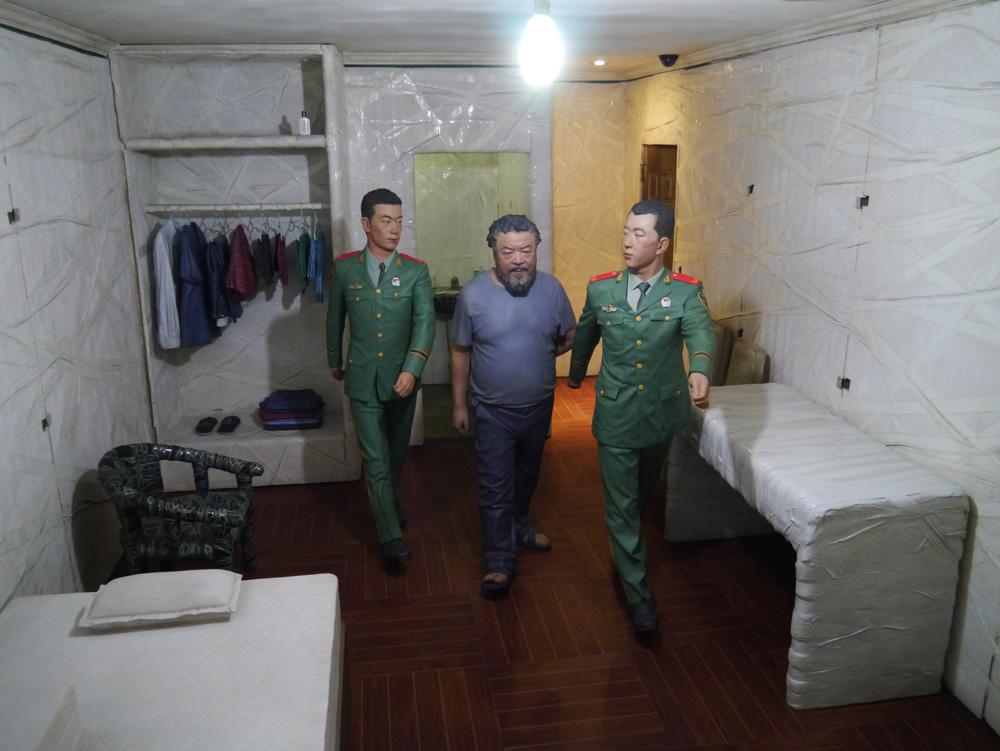In 2011, the artist Ai Weiwei spent 81 days in a Chinese prison on dubious charges of tax evasion. A condition of his release was that he not speak about his experience, but the silence didn’t last long. After a few months, the famously outspoken dissident began talking to foreign journalists, eventually furnishing material for a book and a play, #aiww: The Arrest of Ai Weiwei by Howard Brenton, which was staged in London last spring to generally favourable notices.
Now, with S.A.C.R.E.D., an ambitious installation at this year’s Venice Biennale—one that runs in tandem with the wooden-stool sculpture Bang in the German pavilion and with Straight, his installation of steel rebars from the Sichuan earthquake at the Giudecca—viewers can see exactly what the artist remembers of day-to-day existence in his tiny cell. In what he has described as an exorcism of his ordeal, he has created six, lifelike depictions of his shaggy, iconic figure. Whether asleep in bed, eating a meal or sitting on the toilet, he is always monitored by two anonymous, crisply uniformed guards. Only a single scene in which the prisoner is being interrogated carries a suggestion of menace (the artist was not physically tortured). Instead, the overriding impression is one of claustrophobia, powerlessness and humiliation.
In the compelling mise-en-scène, the sculptural tableaux are hidden inside large black boxes laid out like coffins on the marble floor of a deconsecrated Baroque church. Each iron box has a small window, as do real cells. To see Ai naked in the shower, for example, one mounts a small set of stairs and peers from above like a peeping Tom. The fact that the fibreglass figures, furniture and fixtures are reduced to half human size and exquisitely detailed, down to the shower fixtures and ugly plastic tape on the walls, creates the bizarre impression of a doll’s house. S.A.C.R.E.D. elicits an unsettling assortment of responses: voyeurism, outrage and a child-like fascination with artifice.
There is no escaping the heavy aura of religiosity in this unique and extraordinary work. I was hoping for irony but couldn’t find any, unless in the spectacle of painted Christian saints looking down from the domed ceiling and doing nothing to help. The artist has played the martyr on other occasions and once again it feels like overkill, especially in view of the privilege he enjoys relative to countless Chinese dissidents who have been effectively silenced. Although unfairly deprived of a passport and subject to oppressive surveillance in his daily life, Ai remains free to travel in China, grant interviews and direct the making of art critical of the regime.
In this case, however, it’s worth swallowing a dose of self-aggrandizement. At a time when China, the United States and other superpowers aggressively defend their right to conceal their operations in the name of national security, it is well that artists display what resistance they can. (One hopes that the art world would give equal welcome to scenes from a Guantanamo prison on display in a Chinese temple—but that is another matter.) At considerable risk, Ai uses his freedom to defy the authority of the state—any state—to violate human rights under cloak of secrecy. In his hands, art has the power to vault prison walls, slip past the security detail, unlock the cell door and show the world what it means to be unjustly deprived of freedom and dignity.
The most animated of the six scenes in S.A.C.R.E.D. shows the artist striding towards his cell door, accompanied by armed guards. It appears that he is about to be released. One of his hands is visible, the other hidden behind his back. The implication is clear: art is his secret weapon, and he intends to use it.









